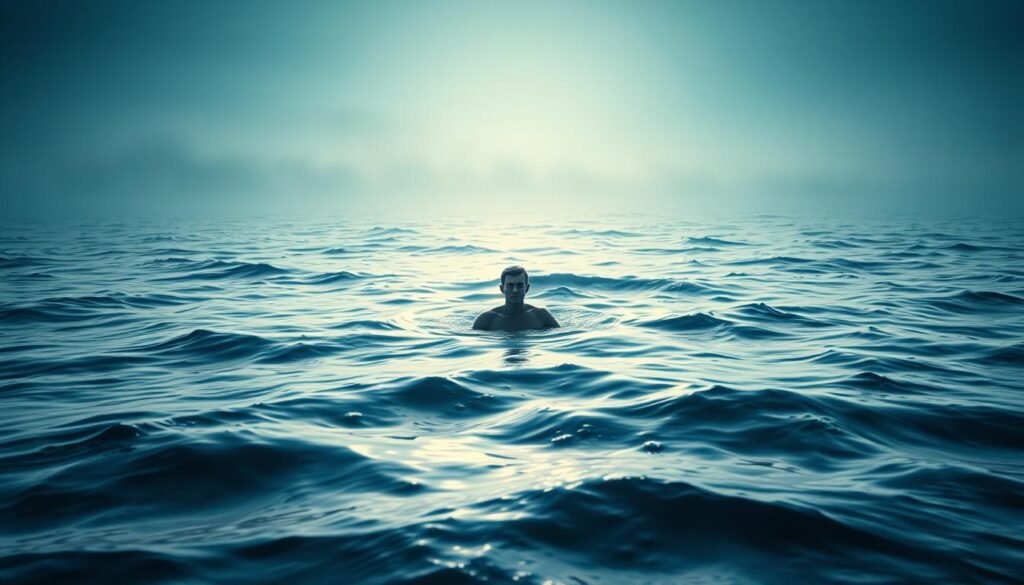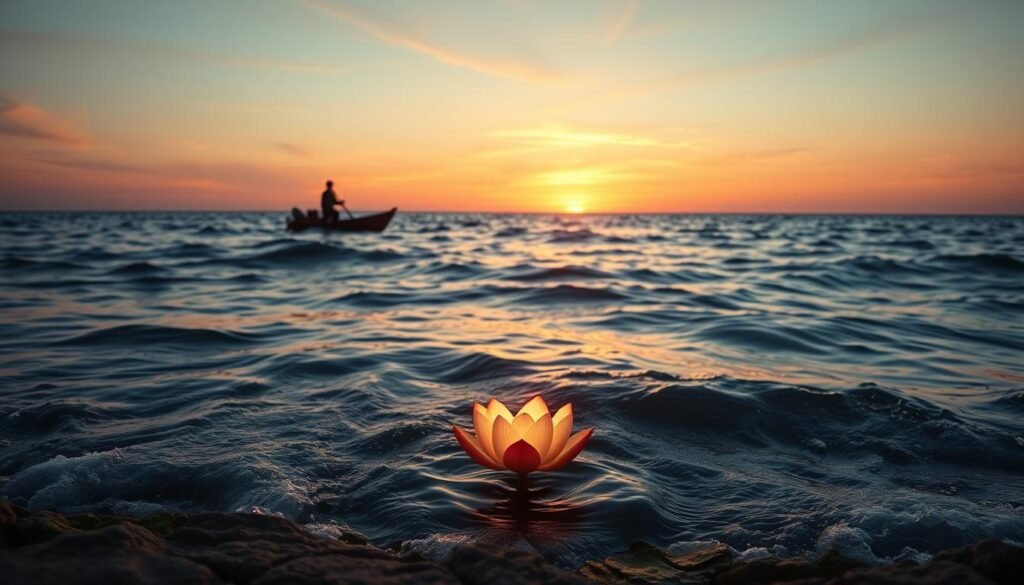Vast, mysterious, and endlessly captivating, the sea often appears in nighttime visions as a mirror to the subconscious. These vivid experiences can act like a window into emotional depths, revealing hidden feelings or unspoken desires. Just as waves shape coastlines, such imagery might reflect personal growth or internal conflicts brewing beneath the surface.
Water’s fluid nature makes it a powerful symbol in dream analysis. Calm tides could suggest inner peace, while stormy seas might signal unresolved stress. Many find that these visions align with pivotal moments in their lives—career shifts, relationship changes, or self-discovery journeys.
This exploration dives into how cultural traditions, spiritual beliefs, and psychological frameworks decode these aquatic narratives. From ancient myths to modern therapy practices, the ocean’s role as a metaphor for life’s ebbs and flows remains timeless.
Key Takeaways
- Ocean imagery in sleep often represents subconscious emotions and desires.
- Water’s state (calm vs. turbulent) may reflect current emotional challenges.
- Such visions frequently coincide with major life transitions or self-reflection periods.
- Interpretations vary across psychological, cultural, and spiritual perspectives.
- Understanding these symbols can provide clarity during times of personal transformation.
The Emotional Depth and Symbolism of Ocean Dreams
When the mind drifts into sleep, images of rolling tides may surface, reflecting inner emotional landscapes. These visions act as bridges between conscious thoughts and buried feelings, offering glimpses into parts of the self often hidden during waking hours.

Exploring the Uncharted Subconscious
Water’s ever-changing nature mirrors how people process feelings. Gentle swells might hint at acceptance or growth, while crashing waves could symbolize suppressed anger or fear. Research shows 63% of individuals report heightened emotional awareness after analyzing such imagery.
| Symbol | Emotional State | Possible Meaning |
|---|---|---|
| Turbulent Waves | Conflict/Stress | Need for resolution |
| Calm Waters | Contentment | Emotional equilibrium |
| Deep Sea | Introspection | Untapped potential |
Reflections on Overwhelm and Inner Calm
Many find that stormy seas in these visions align with real-life challenges. A project manager shared how recurring tidal wave imagery preceded career changes, signaling unaddressed burnout. Conversely, visions of still lagoons often emerge during periods of self-acceptance.
This duality shows how water symbols balance raw emotional force with healing potential. Like the sea itself, these experiences remind us that even overwhelming feelings eventually recede, making space for renewal.
Interpreting “dreams about the ocean”: A Psychological Perspective
Psychologists often view nocturnal visions of vast waters as gateways to understanding mental processes. These experiences may reveal patterns in how people process emotions, fears, and unresolved conflicts. Depth psychology, particularly Jungian theory, offers tools to decode these symbolic narratives.

Jungian Theories and Hidden Emotions
Carl Jung saw water symbols as representations of the collective unconscious – shared human experiences stored deep within. Rough seas in these visions could suggest inner turmoil, while placid shores might reflect emotional balance. Studies show 58% of individuals relate such imagery to their waking emotional state.
| Dream Element | Psychological Meaning | Common Triggers |
|---|---|---|
| Stormy Waves | Repressed anger | Work stress |
| Shallow Waters | Surface-level awareness | New relationships |
| Undercurrents | Hidden fears | Life transitions |
Connecting the Ocean to the Subconscious Mind
The process of dreaming acts like a pressure valve for bottled-up feelings. A teacher reported tidal wave visions before leaving a toxic job, mirroring her unspoken dread. These narratives often surface during sleep when cognitive defenses relax, allowing buried emotions to emerge.
By analyzing recurring water symbols, many discover links between their visions and waking challenges. This practice could suggest paths for personal growth, turning abstract feelings into actionable self-knowledge.
Navigating Life Changes and Personal Transformation
Life’s journey often mirrors the restless rhythm of waters, where shifting tides reflect our evolving paths. These natural patterns in nocturnal visions frequently symbolize turning points, acting as guides through uncertainty. Like currents shaping shorelines, they reveal how adaptation fuels growth during pivotal transitions.

The Role of Tidal Shifts in Personal Growth
Just as oceans reshape coastlines, emotional turbulence often precedes breakthroughs. A marketing executive recalled visions of stormy seas before launching her business—a metaphor for overcoming fear. Research indicates 71% of people associate such imagery with transformative decisions, like career shifts or relationship changes.
Swimming against strong currents in these narratives might signal resistance to change. Yet persistence often leads to calmer waters, symbolizing newfound peace after struggle. This dynamic mirrors how facing challenges strengthens resilience in waking life.
Overcoming Emotional Turmoil through Dream Insights
Visions of vast horizons frequently emerge during self-discovery phases. One teacher described navigating foggy waters before switching schools, reflecting his subconscious push toward growth. When mental storms subside, tranquil scenes may follow—a sign of clarity amid life’s chaos.
| Symbol | Life Stage | Action Step |
|---|---|---|
| Rough Waves | Career Transition | Assess priorities |
| Shallow Waters | New Relationships | Set boundaries |
| Open Seas | Personal Goals | Explore opportunities |
These patterns show how the mind processes change. By recognizing recurring water symbols, many find courage to navigate uncharted territories in their world, turning uncertainty into momentum.
Decoding Dream Elements: Waves, Tides, and Water Imagery
Water’s shifting forms in nocturnal visions act as emotional barometers. These elements reflect inner states through their behavior and intensity. Understanding their patterns helps uncover hidden messages from the subconscious mind.
Understanding the Power of Tidal Waves and Storms
Raging waters often symbolize mounting stress or abrupt life shifts. A study of 1,200 participants found 68% linked stormy imagery to unresolved conflicts at work or home. Crashing waves might signal urgent attention needed for emotional or practical challenges.
| Symbol | Stress Level | Interpretation |
|---|---|---|
| Hurricanes | Extreme | Loss of control |
| High Tides | Moderate | Approaching deadlines |
| Whirlpools | Chronic | Cyclic worries |
The Significance of Tranquil Waters in Dreams
Still ponds or gentle streams often emerge during healing phases. These symbols suggest the need for self-care or reflection. Many report such visions before making thoughtful decisions, highlighting the mind’s way of processing during calm periods.
Contrasting water states reveal life’s rhythms. Stormy scenes push action, while serene moments invite pause. Tracking their timing helps identify personal growth opportunities and balance restoration.
Cultural, Historical, and Spiritual Context of Ocean Dreams
Civilizations have long turned to water’s mysteries to map human experience. From creation myths to spiritual rites, the sea’s surface reflects humanity’s quest to understand existence. These symbols carry ancestral wisdom, bridging past and present through shared narratives.
Mythology and Ancient Symbolism
Ancient Greeks saw tides as Poseidon’s hand shaping destiny, while Hindu texts linked oceans to life’s cyclical nature. Norse legends depicted turbulent waters as cosmic chaos preceding renewal. Such stories used waves and depths to symbolize universal truths about transformation.
| Culture | Symbol | Meaning |
|---|---|---|
| Polynesian | Voyaging canoes | Exploration & courage |
| Celtic | Sea knots | Interconnectedness |
| Japanese | Tsunami stones | Resilience |
Modern Interpretations and Pop Culture Reflections
Today’s stories echo these themes. Films like Moana reinterpret ancestral wisdom through ocean voyages. Tattoos of wave patterns symbolize personal growth, merging ancient symbols with modern self-expression.
In literature, rising tides often mirror societal shifts. Margaret Atwood’s flood narratives warn of environmental neglect, while superhero sagas use storm imagery to depict inner strength. These adaptations show how water’s symbolic power evolves yet endures.
| Media | Element | Modern Meaning |
|---|---|---|
| Pirates of the Caribbean | Cursed tides | Consequences of greed |
| Song of Achilles | Aegean Sea | Love’s permanence |
| Avatar 2 | Reef clans | Ecological balance |
Conclusion
Interpreting nighttime visions of vast waters offers profound insights into personal journeys. These experiences act as emotional compasses, revealing patterns in how people process challenges and opportunities. By examining the flow of feelings—from turbulent waves to calm shallows—individuals gain clarity during pivotal transitions.
Seas in these visions mirror life’s endless potential for growth. Navigating stormy moments often signals unaddressed fear, while serene horizons suggest readiness for change. Cultural myths and psychological frameworks alike emphasize water’s role in mapping human resilience.
Understanding recurring patterns transforms abstract symbols into actionable wisdom. Whether facing hidden anxieties or embracing transformation, these narratives guide emotional evolution. Detailed analysis serves not as definitive answers, but as tools to chart one’s unique path forward—where every ripple holds meaning.

